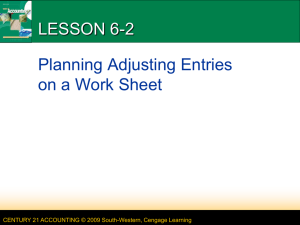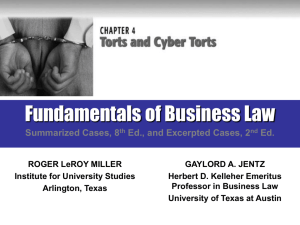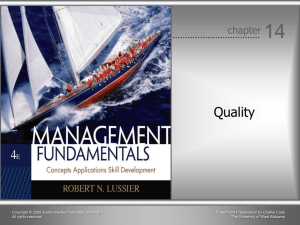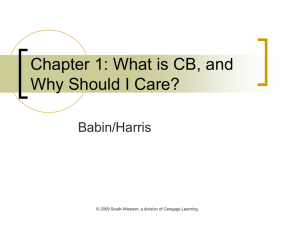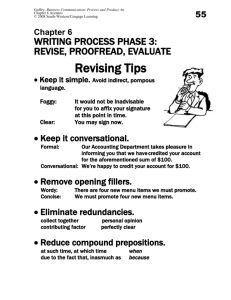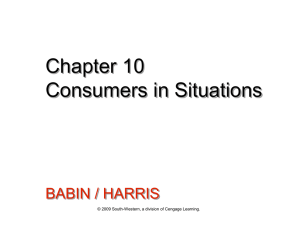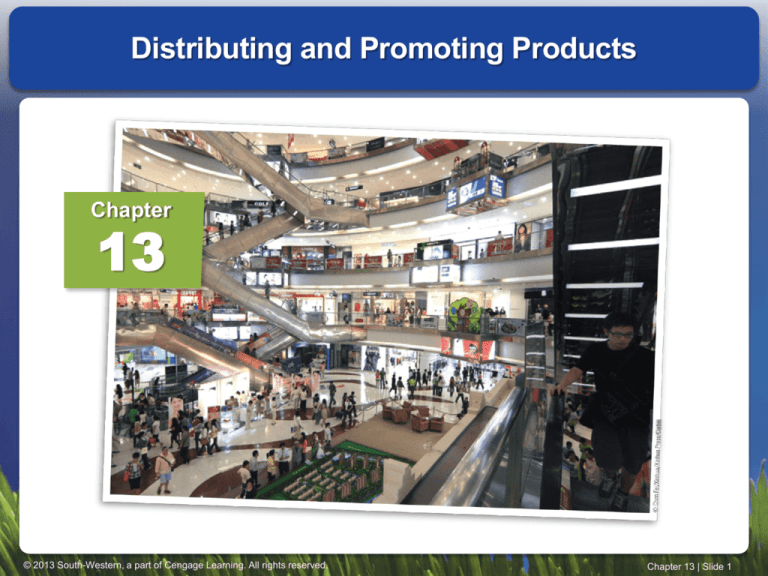
Distributing and Promoting Products
Chapter
13
© 2013 South-Western, a part of Cengage Learning. All rights reserved.
Chapter 13 | Slide 1
4 P’s of the Marketing Mix
Promotion
The particular combination of promotion methods
a firm uses to reach a target market
• Advertising
–
A paid non-personal message communicated to a select
audience through a mass medium
• Personal selling
–
Personal communication aimed at informing customers and
persuading them to buy a firm’s products
• Sales promotion
–
The use of activities or materials as direct inducements to
customers or salespersons
• Public relations
–
Communication activities used to create and maintain favorable
relations between an organization and various public groups,
both internal and external
© 2013 South-Western, a part of Cengage Learning. All rights reserved.
Chapter 13 | Slide 3
Possible Elements of a Promotion Mix
© 2013 South-Western, a part of Cengage Learning. All rights reserved.
Chapter 13 | Slide 4
Advertising (cont.)
Advertising Age is the industry’s preeminent
source of marketing, advertising, and media news,
information, and analysis.
http://www.adage.com
© 2013 South-Western, a part of Cengage Learning. All rights reserved.
Chapter 13 | Slide 5
Examples of TV ads
Slinky 1960’s
Old Spice
VW commercial: Darth Vader (Superbowl
2011)
VW commercial: Dog Gets Fit (Superbowl
2012)
The Making of the VW Commercial
© 2013 South-Western, a part of Cengage Learning. All rights reserved.
Chapter 13 | Slide 6
Major Steps in Developing an
Advertising Campaign
1.
Identify and analyze the target audience.
2.
Define the advertising objectives.
3.
Create the advertising platform.
4.
Determine the advertising appropriation.
5.
Develop the media plan.
6.
Create the advertising message.
7.
Execute the campaign.
8.
Evaluate advertising effectiveness.
© 2013 South-Western, a part of Cengage Learning. All rights reserved.
Chapter 13 | Slide 7
Advertising Agencies
Independent firms that plan, produce, and place
advertising for their clients
Large agencies also help with sales promotion
and public relations
Media usually pay a commission to agencies
Example: Deep Local Ad Agency
© 2013 South-Western, a part of Cengage Learning. All rights reserved.
Chapter 13 | Slide 8
Sales Promotion
Activities or materials that are direct
inducements to customers or salespersons
Sales promotion objectives
• To attract new customers
• To encourage trial of a new product
• To invigorate the sales of a mature brand
• To boost sales to current customers
• To reinforce advertising
• To increase traffic in retail stores
• To steady irregular sales patterns
• To build up reseller inventories
• To neutralize competitive promotional efforts
• To improve shelf space and displays
© 2013 South-Western, a part of Cengage Learning. All rights reserved.
Chapter 13 | Slide 9
Sales Promotion Methods (cont.)
Rebate
• A return of part of the purchase price of a product
Coupon
• Reduces the retail price of a particular item by a stated amount
at the time of purchase
Sample
• A free product given to customers to encourage trial and
purchase
Premium
• A gift a producer offers to a customer in return for buying its
product
Frequent-user incentives
• A program that rewards customers who engage in repeat
(frequent) purchases
© 2013 South-Western, a part of Cengage Learning. All rights reserved.
Chapter 13 | Slide 10
Sales Promotion Methods (cont.)
Point-of-purchase displays
• Promotional material in the retail store designed to inform
customers and encourage purchases
Trade shows
• Industry-wide exhibits at which many sellers display their
products
Buying allowance
• A temporary price reduction to resellers for purchasing
specified quantities of a product
Cooperative advertising
• A manufacturer agrees to pay a certain amount of the retailer’s
media cost for advertising the manufacturer’s product
© 2013 South-Western, a part of Cengage Learning. All rights reserved.
Chapter 13 | Slide 11
Public-Relations (PR)
A broad set of communication activities used to
create and maintain favorable relationships
between an organization and various public groups,
both internal and external
• Customers, employees, stockholders, suppliers,
educators, the media, government officials, society
in general
Types of public-relations tools
• Written and spoken communications
–
Brochures, newsletters, company magazines, annual reports,
news releases, corporate-identity materials, speeches
• Event sponsorship
–
Special events such as concerts and charity functions that the firm
underwrites wholly or partially
© 2013 South-Western, a part of Cengage Learning. All rights reserved.
Chapter 13 | Slide 12
Publicity
Publicity
• Communication in news-story form about an
organization, its products, or both
–
News release
– Feature article
– Captioned photograph
– Press conference
© 2013 South-Western, a part of Cengage Learning. All rights reserved.
Chapter 13 | Slide 13
The Uses of Public Relations
To promote people, places, activities, ideas
To enhance the reputation of the organization
by increasing awareness of company products
and activities
To create specific positive company images
© 2013 South-Western, a part of Cengage Learning. All rights reserved.
Chapter 13 | Slide 14
Distribution
Channel of distribution
• A sequence of marketing organizations that directs
a product from the producer to the ultimate user
© 2013 South-Western, a part of Cengage Learning. All rights reserved.
Chapter 13 | Slide 15
Channels for Consumer Products
Producer to consumer (direct channel)
• No intermediaries (“middle men”)
• Used by all services and by a few consumer goods
• Producers can control quality and price, do not have
to pay for intermediaries, and can be close to their
customers
• Examples: Dell Computer, Mary Kay Cosmetics
© 2013 South-Western, a part of Cengage Learning. All rights reserved.
Chapter 13 | Slide 16
Channels for Consumer Products (cont.)
Producer to retailer to consumer
• Producers sell directly to retailers when retailers (e.g.,
Walmart) can buy in large quantities
• Most often used for bulky products for which
additional handling would increase selling costs,
and for perishable or high-fashion products that
must reach consumers quickly
© 2013 South-Western, a part of Cengage Learning. All rights reserved.
Chapter 13 | Slide 17
Channels for Consumer Products (cont.)
Producer to wholesaler to retailer
to consumer
• The traditional channel
• Used when a producer’s products are carried by
so many retailers that the producer cannot deal
with them all
© 2013 South-Western, a part of Cengage Learning. All rights reserved.
Chapter 13 | Slide 18
Distribution Channels
© 2013 South-Western, a part of Cengage Learning. All rights reserved.
Chapter 13 | Slide 19
Level of Market Coverage
Intensity of market coverage
• Intensive distribution
– The use of all available outlets for a product to
saturate the market
• Selective distribution
– The use of only a portion of the available outlets for a
product in each geographic area
• Exclusive distribution
– The use of only a single retail outlet for a product in a
larger geographic area
© 2013 South-Western, a part of Cengage Learning. All rights reserved.
Chapter 13 | Slide 20
The Ten Largest Retail Firms in the United States
© 2013 South-Western, a part of Cengage Learning. All rights reserved.
Chapter 13 | Slide 21
Using the Internet
The National Retail Federation is a gateway
for information for the retailing industry.
http://www.nrf.com
© 2013 South-Western, a part of Cengage Learning. All rights reserved.
Chapter 13 | Slide 22
Physical Distribution
All those activities concerned with the
efficient movement of products from the
producer to the ultimate user
•
•
•
•
•
Inventory management
Order processing
Warehousing
Materials handling
Transportation
© 2013 South-Western, a part of Cengage Learning. All rights reserved.
Chapter 13 | Slide 23
Physical Distribution (cont.)
Inventory management
• The process of managing inventories in such a way as
to minimize inventory costs
–
–
Holding costs—the costs of storing products until they are
purchased or shipped to customers
Stock-out costs—the costs of sales lost when items are
not in inventory when needed
Order processing
Warehousing
Materials Handling-in warehouse and in transport
Transportation
© 2013 South-Western, a part of Cengage Learning. All rights reserved.
Chapter 13 | Slide 24
Physical Distribution (cont.)
Transportation
• Trucks
–
Tremendous expansion since creation of national highways
– Often favored for offering door-to-door service, less stringent
packaging requirements, and flexible schedules
• Airplanes
–
–
Fastest but most expensive
Used to ship high-value or perishable goods
• Waterways
– Slowest but least expensive
– Used mainly for bulky, nonperishable goods
– Use limited to cities located on navigable waterways
• Pipelines
–
used primarily to carry petroleum and natural gas
© 2013 South-Western, a part of Cengage Learning. All rights reserved.
Chapter 13 | Slide 25
Characteristics of Transportation Modes
© 2013 South-Western, a part of Cengage Learning. All rights reserved.
Chapter 13 | Slide 26
Classes of In-Store Retailers
Independent retailer
• A firm that operates only one retail outlet
Chain retailer
• A company that operates more than one retail outlet-
Walgreens, Starbucks
Department store
• A retail store that:
– employs twenty-five or more persons
– sells at least home furnishing, appliances, family apparel,
and household linens and dry goods, each in a different
part of the store
Discount store
• A self-service, general-merchandise outlet that sells
products at lower-than-usual prices
© 2013 South-Western, a part of Cengage Learning. All rights reserved.
Chapter 13 | Slide 27
Classes of In-Store Retailers (cont.)
Catalog showroom
• A retail outlet that displays well-known brands and
sells them at discount prices through catalogs within
the store
Warehouse showroom
• A retail facility in a large, low-cost building with large
on-premises inventories and minimal service
Convenience store
• A small food store that sells a limited variety of
products but remains open well beyond normal
business hours
© 2013 South-Western, a part of Cengage Learning. All rights reserved.
Chapter 13 | Slide 28
Classes of In-Store Retailers (cont.)
Supermarket
• A large self-service store that sells primarily food
and household products-Copps
Superstore
• A large retail store that carries not only food and
nonfood products ordinarily found in supermarkets
but also additional product lines-Walmart
Superstores
Warehouse club
• A large-scale members-only establishment that
combines features of cash-and-carry wholesaling
with discount retailing-”Sam’s Club”
© 2013 South-Western, a part of Cengage Learning. All rights reserved.
Chapter 13 | Slide 29
Classes of In-Store Retailers (cont.)
Traditional specialty store
• A store that carries a narrow product mix with deep
product lines- “Baseball Card Store”
Off-price retailer
• A store that buys manufacturers’ seconds, overruns,
returns, and off-season merchandise for resale to
consumers at deep discounts
Category killer
• A very large specialty store that concentrates on a
single product line and competes on the basis of low
prices and product availability
Examples: Toys “R” Us, Home Depot, Best Buy, Barnes & Noble
© 2013 South-Western, a part of Cengage Learning. All rights reserved.
Chapter 13 | Slide 30
Kinds of Nonstore Retailing
A type of retailing whereby consumers
purchase products without visiting a store
• Direct selling
–
The marketing of products to consumers
through “in person” sales presentations at home
or in the workplace-Tupperware, Tastefully
Simple
• Direct marketing
–
The use of the telephone, Internet, TV and
nonpersonal media to introduce products to
customers, who can then purchase them via
mail, telephone, or the Internet
–
Home Shopping Network
© 2013 South-Western, a part of Cengage Learning. All rights reserved.
Chapter 13 | Slide 31
Many Examples of Nonstore Retailing
Catalog marketing
• An organization provides a catalog from which
customers make selections and place orders by
mail, telephone, or the Internet
Direct-response marketing
• A seller advertises a product and makes it available,
usually for a short time period, through mail,
telephone, or online orders
Telemarketing
• The performance of marketing-related activities by
telephone
© 2013 South-Western, a part of Cengage Learning. All rights reserved.
Chapter 13 | Slide 32
More Examples of Nonstore Retailing
Television home shopping
• Products are presented to television viewers, who
can buy them by calling a toll-free number and
paying by credit card
Online retailing
• Makes products available to buyers through
computer connections
Automatic vending
• The use of machines to dispense products
© 2013 South-Western, a part of Cengage Learning. All rights reserved.
Chapter 13 | Slide 33
Chapter Quiz
1. A women’s apparel manufacturer most likely
will use
A.
B.
C.
D.
E.
intensive distribution.
selective distribution.
exclusive distribution.
high-style distribution.
popular-style distribution.
© 2013 South-Western, a part of Cengage Learning. All rights reserved.
Chapter 13 | Slide 34
Chapter Quiz
2. Which activity combines inventory management,
order processing, warehousing, material
handling, and transportation?
A.
B.
C.
D.
E.
Marketing
Merchandising
Warehousing
Physical distribution
Transporting
© 2013 South-Western, a part of Cengage Learning. All rights reserved.
Chapter 13 | Slide 35

